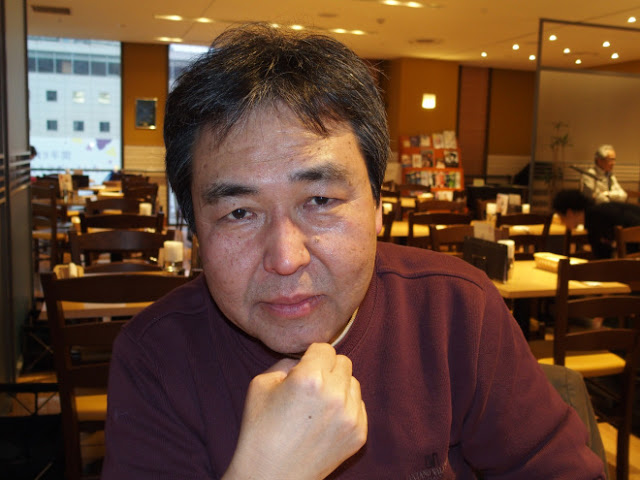
Prolific Godzilla series screenwriter Wataru Mimura in 2015. Photo © Brett Homenick.
Since the early 1990s, Wataru Mimura has been one of the Godzilla series’ most prolific screenwriters. His first Godzilla film was the landmark Godzilla vs. Mechagodzilla II (1993), which is still a fan favorite to this day. Following that success, Mr. Mimura helped revive the Godzilla franchise with his work on Godzilla 2000 (1999) (with Hiroshi Kashiwabara), which ultimately led to his writing screenplays for Godzilla vs. Megaguirus (2000) (also with Mr. Kashiwabara), Godzilla vs. Mechagodzilla (2002), and Godzilla: Final Wars (2004). Mr. Mimura answered Brett Homenick’s questions about his contributions to the Godzilla series in an interview translated by totorom.
Note: This interview was conducted in 2008.
Brett Homenick: How did you start your career as a writer?
Wataru Mimura: My mentor was a master director at Shochiku, Mr. Yoshitaro Nomura. I studied writing with him in my late 20s to early 30s. I collected related materials and did some research for his scenarios (screenplays). That was my entrance into the movie industry.
When I was 33 years old, I met a young man working in the industry. He, Noritsugu Tsubomi, was a freelance movie producer and gave me an opportunity to write a scenario for his movie. It was a movie called Freeter (1987). Mr. Tsubomi is the movie producer whom I trust the most, and we still have a good friendship.
BH: How did you get hired as the writer for Godzilla vs. Mechagodzilla II (1993)?
WM: Before Godzilla vs. Mechagodzilla II, Mr. Shogo Tomiyama, a producer at Toho, asked me to write Yamato Takeru (a.k.a. Orochi the Eight-Headed Dragon). As you know, Yamato Takeru is a tokusatsu movie, too. It seems Mr. Tomiyama liked the quality of my scenario for Yamato Takeru, and he thought I was good at writing tokusatsu movies.
Several years earlier, I had a chance to work with another Toho producer, Mr. Koji Hashimoto (director of Godzilla, 1984). We were going to make a comedy movie (a kind of revival of the “Wakadaisho”/“Young Guy” series), but it did not work out. Then Mr. Hashimoto introduced me to Mr. Tomiyama. That is how I got the job to write Yamato Takeru. Mr. Tomiyama asked me again to write the plot for Godzilla vs. Mothra (1992). The actual scenario was, however, written by Mr. Kazuki Omori, so my plot was not adopted. Mr. Tomiyama still seemed to like my ability to write tokusatsu movies, so he asked me to write Yamato Takeru. That led to Godzilla vs. Mechagodzilla II.
BH: What were some of your original ideas for this movie?
WM: The story of Godzilla vs. Mechagodzilla II was based on the plot I wrote earlier for Godzilla vs. Mothra. The theme was “Life.” Godzillasaurus deposited an egg in the nest of the Pteranodon. I like this brood parasitism idea, which is quite original for the movie. Baby Godzilla and Rodan were tied with a brother-like bond. It is a bond between (two) lives.
BH: How was the English dialogue handled?
WM: I was not involved in the English dialogue at all. The translation specialist did the job.
BH: Please describe your work on Yamato Takeru as the screenwriter.
WM: I already wrote earlier how I got hired for this movie. I had been interested in the legends of Japan for a long time, so I really enjoyed working on it. I wanted to write something like John Milius’ Conan the Barbarian, but it was not easy to match Conan the Barbarian. Yamato Takeru was originally going to be a trilogy. So this movie was the first part of the trilogy, and that is why it did not have a boss character (head villain). Unfortunately, it was not a big hit, and we could not make sequels. I am still hoping to complete the story of the trilogy in my lifetime.
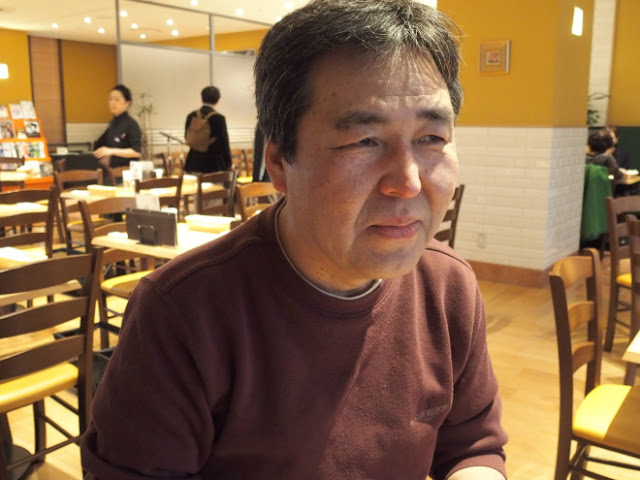
Photo © Brett Homenick.
BH: When Godzilla returned in Godzilla 2000, you and Hiroshi Kashiwabara were hired to write it. How did you and Mr. Kashiwabara get hired?
WM: It is the producer’s job to choose screenwriters, so Mr. Kashiwabara and I do not know why we both got the offer to write Godzilla 2000. Maybe I should say two brains are stronger than one, as long as the two get along well. I did not know Mr. Kashiwabara before. He was an open-minded person, and we worked together well.
BH: What was the process of writing the movie?
WM: We divided the story into four parts. Mr. Kashiwabara wrote “Part A” and “Part C.” I did “Part B” and “Part D.” Then we put them together to complete the whole story. After the movie was completed, we realized this writing process did not work well. The finished scenario did not have consistency. It was as if the writers’ minds in the story were scattered. Learning from this mistake, we tried a different method for the next movie, Godzilla vs. Megaguirus. We divided the story into two parts. Mr. Kashiwabara wrote the first half, and I did the second. This approach was easier, as I could write with a constant mind. Comparing those two movies, Godzilla vs. Megaguirus has a better quality.
BH: Did you or Mr. Kashiwabara have any ideas that couldn’t be used?
WM: Frankly speaking, as the years passed, I do not have a clear memory of the details. I can say, however, that both of us, Mr. Kashiwabara and I, are not satisfied with this movie at all. Mr. Okawara, the director of the movie, seemed not happy with our job, either, so he wrote the scenario himself. The final scenario had a lot of input from Mr. Okawara. So Mr. Kashiwabara and I do not feel comfortable to say this is our work. I was frustrated with this fact, so I tried my very best in writing this story for a novel. I do not know if the novel has been issued in the U.S., but it should be far more enjoyable than the movie.
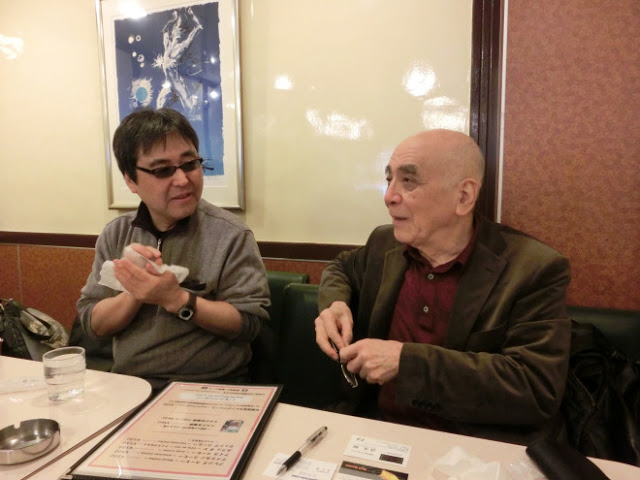
Mr. Mimura meets director Yoshimitsu Banno. Photo © Brett Homenick.
BH: For Godzilla vs. Megaguirus, what were some of your original ideas for this movie?
WM: I should say it is the “Dimension Tide.” Kiriko locked “Dimension Tide,” while falling down without control, on Gryphon and crashed into Godzilla.
BH: How did you come up with the Dimension Tide idea?
WM: I was trying to come up with a most unexpected weapon against Godzilla. I thought it was impossible to destroy Godzilla with any weapon available today. It was an interesting idea to shoot Godzilla beyond the atmosphere, which was a large-scale idea. The idea just popped up to me. Of course, I had the Strategic Defense Initiative of the U.S. Air Force in my mind.
BH: When Godzilla vs. Mechagodzilla was written in 2002, Mr. Kashiwabara did not co-write it. Why was he not involved?
WM: As I wrote earlier, it is a producer’s job to choose screenwriters. So I have no idea. Please ask Mr. Tomiyama. Mr. Kashiwabara is a very busy screenwriter, so he might have been occupied with other projects at that time. I do not really know why.
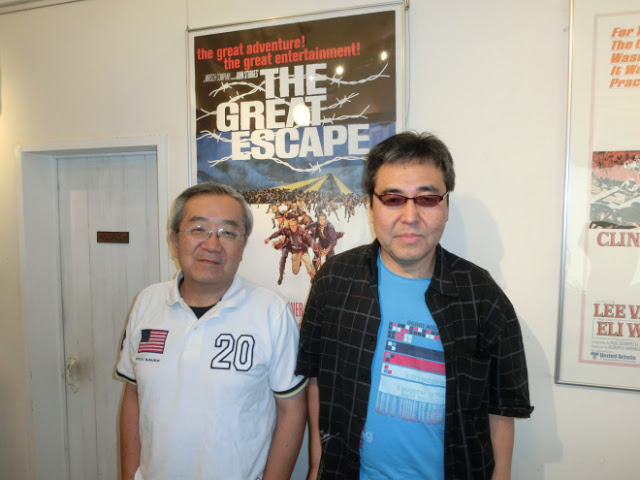
Screenwriters Hiroshi Kashiwabara and Wataru Mimura. Photo © Brett Homenick.
BH: Did Toho have much input when it came to writing the script?
WM: I did not receive any particular requests from Toho. I have written several Godzilla movies, so I am confident I understand what is required for Godzilla movies. Mr. Tomiyama trusts me and leaves everything to me.
BH: How did you get hired to co-write Godzilla: Final Wars?
WM: Toho decided it was going to be the last Godzilla movie, so my writing team joined the plot, planning about one year before the actual production. It was Mr. Tomiyama’s idea. When the plot was completed, I wrote the first scenario. After that, Mr. Isao Kiriyama from the team of Mr. Ryuhei Kitamura, director of the movie, co-wrote the revised scenario together with Mr. Kitamura. The story line was not changed, but the nature of the characters and some words changed, according to Mr. Kitamura’s taste.
BH: What was Ryuhei Kitamura like to work with?
WM: I had never worked with Mr. Kitamura before. As I wrote earlier, I started working on the plot more than one year before, and they did not yet decide who was going to direct the movie. Mr. Kitamura joined the project after the screenwriter was chosen and the plot was written. So it was not up to him to choose which screenwriter to work with. I guess it was not easy for him to work with me, as we had not known each other before. That is why Mr. Isao Kiriyama from his team joined the project later.
BH: What did you think of Godzilla: Final Wars?
WM: It was the last movie of the Godzilla series, so I wanted to make it something you can enjoy as “party movie” with a lot of familiar kaiju characters. I am not sure if you could really enjoy it. I personally think that the kaiju could have been featured more in the movie. If I score the quality, it would be 50 points (out of 100). The missing 50 points is my expectation for the next Godzilla movie. The last movie was not perfect, so you can expect (more satisfaction from) the next one.
BH: Do you have any final comments for (the) readers?
WM: I do not know when Godzilla will revive again. Maybe 10 years later or 20 years later. Anyway, let’s wait for the day he comes back. Don’t worry. He will come back again and again, as long as we humans are stupid.
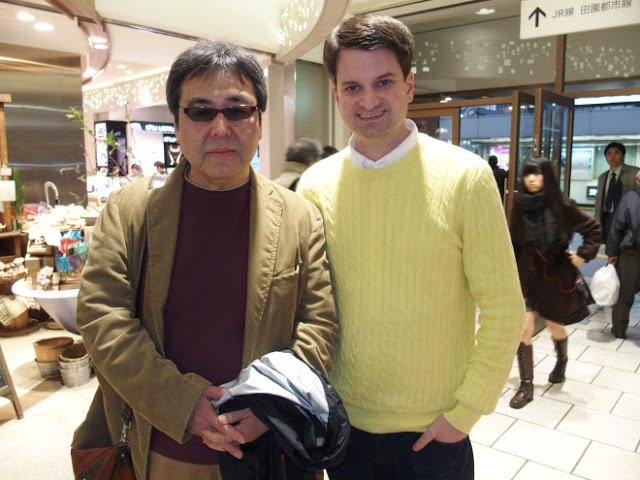
Mr. Mimura poses for a photo with Brett Homenick in Tokyo. Photo © Brett Homenick.